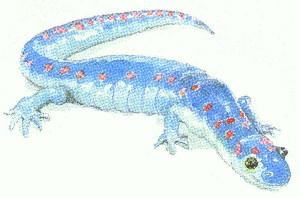lined link to go to subject)
Chapter 1. Vision
System Design
Chapter 2. Biological Eye Designs
Chapter
3. Eye
Design
Illustrations
A.
Plant
light sensing
1.
Grass, simple vines,
and stems
2.
Flowers
B.
Lower
animal eyes
1.
Flatworms
2.
Clams and Scallops
3.
Nautilus
4.
Shrimp
5.
Crab
6.
Octopus and
giant squid
7.
Spiders
8.
Scorpions
8.
Brittle Star
C.
Insect
eyes
1.
Bees
2. Dragonflies
3. Butterflies
4.
Flies
5.
Ants
6.
Moths
7.
Beetles
8.
Wasp
D. Fish
eyes
1.
Shark
2.
Flounder
3.
Four-eyed fish
E.
Amphibian
eyes
1. Frog
2.
Salamander
F.
Reptile
eyes
1. Boa
constrictor
2.
Rattle
snake
3.
Lizard
4.
Turtle
5.
Crocodile
and
alligators
G. Bird
eyes
1.
Eagles
2.
Hummingbirds
3. Owls
4.
Ostrich
5.
Cormorants
H.
Mammal
eyes
1.
Whales
2.
Elephants
3. Lions,
tigers, and
other cats
4.
Monkeys
5. Rats
and mice
6. Bats
7.
Tarsier
I.
Human
eyes
1. Iris
2. Lens
3.
Retina
Chapter
4. Eye
Reproduction
Chapter 5.
Optical
Systems
Design
Chapter 6.
The Eye Designer
Related
Links
Appendix A -
Slide Show & Conference Speech
by Curt Deckert
Appendix B -
Conference Speech
by Curt Deckert
Appendix C -
Comments From Our Readers
Appendix D -
Panicked Evolutionists: The Stephen Meyer Controversy
Chapter 3
Section E
(Click on PICTURE IN TEXT to bring up LARGE PICTURE)
3. EYE DESIGN
ILLUSTRATIONS
E.
Amphibian eyes
Most amphibians, such as frogs
and salamanders,
have color vision, even though they may be restricted to narrower bands
of the visible color spectrum than are humans. There are at least four
types of photoreceptors or optical sensors with different chemical
composition
that allow seeing different amounts of color by amphibians. Since
amphibians
have been around a long time and have adapted to a variety of
environments,
their eye configurations vary slightly for different environments.
Amphibian
eyes contain photoreceptors like those of some fish. Some fish are
vulnerable
to the changes of light intensity as it varies with water depth. There
are some amphibians with nearly-complete 360-degree vision. They have a
neural mechanism to contract their pupils, like some species of fish.
The
following are a few examples of amphibian eyes.
1.
Frog
Frogs have an interesting
iris for light control in each eye. Frogs have many different shapes of
the iris defining the pupils. They may be heart, pear, round or oval
shaped,
with each shape unique to a particular design of frog. Frogs can adjust
their focus to both near and far images. This is further evidence of
diverse,
yet specific, purposeful design. They also have special movable eye
socket
arrangements for looking around to detect predators and food. Their
socket
arrangements are somewhat similar to the design of military optics
mounted
on aircraft. Some frogs' eyes are
large and disproportional
in size with respect to their bodies. Tadpoles have smaller eyes that
see
limited color. Variations in the color of frogs' eye come from pigment
differences in each type of frog.
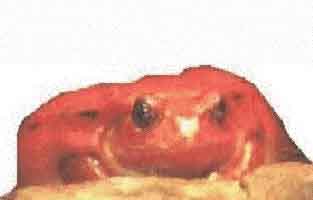
Eyes. (By Bruce Chambers) |
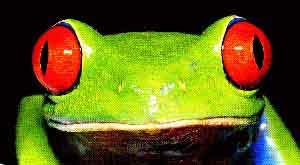
p 02 Reptiles & Amphibians |
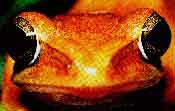
Whipping Frog Eyes, p. 05 Reptiles & Amphibians |
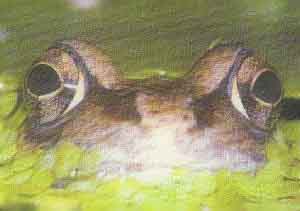
Eyes, p 325, Exploring the Secrets of Nature, 1994, Readers Digest) |
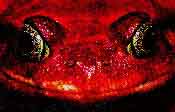
Tomato Frog Eyes, p. 07 Reptiles & Amphibians |
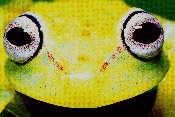
Tree Frog Eyes, p. 11 Reptiles & Amphibians |
2. Salamander
Although
salamander’s eyes are considered primitive, they are not
necessarily less complicated than eyes of invertebrates.
Salamanders range from one inch to 60 inches long. Some
salamanders have proportionally
large eyes.
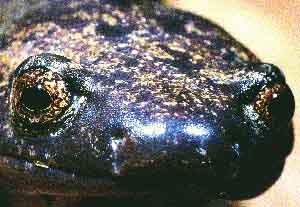
Alta Verapaz Salamander Eyes p 18, Reptiles & Amphibians |
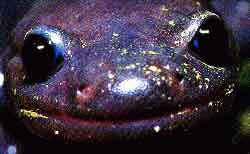
Boulanger's Oriental Salamander Eyes p 19b, Reptiles & Amphibians |
(Figures 3.29 through 3.31 for frogs and salamanders from Reptiles & Amphibians, used by permission of the photographer and copyright owner Ryu Uchiyama, and the publisher, Chronicle Books, San Francisco, CA 94105)
Contents
Eye Home Page
[Chap-1a] - [1bc]
[Chap-2abc] - [2def] - [2ghi]
[Chap-3a] - [3b] - [3c] - [3d] - [3e] - [3f] - [3g] - [3h] - [3i]
[Chap-4a] - [4b] - [4cd]
[Chap-5ab] - [5cd]
[Chap-6a] - [6b] - [6c]
Related Links
Appendix A - Slide Show & Conference Speech by Curt Deckert
Appendix B - Conference Speech by Curt Deckert
Appendix C - Comments From Our Readers
Appendix D - Panicked Evolutionists: The Stephen Meyer Controversy
Table of All Figures
